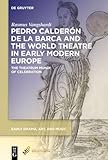Pedro Calderón de la Barca and the World Theatre in Early Modern Europe : The Theatrum Mundi of Celebration / Rasmus Vangshardt.
Material type: TextSeries: Early Drama, Art, and MusicPublisher: Kalamazoo, MI : Medieval Institute Publications, [2023]Copyright date: ©2024Description: 1 online resource (XIV, 240 p.)Content type:
TextSeries: Early Drama, Art, and MusicPublisher: Kalamazoo, MI : Medieval Institute Publications, [2023]Copyright date: ©2024Description: 1 online resource (XIV, 240 p.)Content type: - 9781501527173
- 9781501517020
- 9781501517006
- Theater -- Europe -- History -- 16th century
- Theater -- Europe -- History -- 17th century
- Calderón de la Barca, Pedro
- Europa/Frühe Neuzeit
- Spanien/Goldenes Zeitalter
- Welttheater
- LITERARY CRITICISM / European / Spanish & Portuguese
- Early Modern Europe
- Golden Age Spain
- Pedro Calderón de la Barca
- Theatrum Mundi
- World Theater
- 792.09409032
- PN2174 .V36 2024
- online - DeGruyter
- Issued also in print.
| Item type | Current library | Call number | URL | Status | Notes | Barcode | |
|---|---|---|---|---|---|---|---|
 eBook
eBook
|
Biblioteca "Angelicum" Pont. Univ. S.Tommaso d'Aquino Nuvola online | online - DeGruyter (Browse shelf(Opens below)) | Online access | Not for loan (Accesso limitato) | Accesso per gli utenti autorizzati / Access for authorized users | (dgr)9781501517006 |
Frontmatter -- Acknowledgements -- Contents -- Texts and Translations -- Introduction: Plaything or Purpose -- Chapter 1 A Poetics of Festivity -- Chapter 2 A Circular Colosseum: The Loa -- Chapter 3 El gran teatro del mundo -- Chapter 4 Aesthetic Theodicy -- Conclusion: “The Modern Age Begins with an Act of Theodicy” -- Bibliography -- Index of Names
restricted access online access with authorization star
http://purl.org/coar/access_right/c_16ec
Rasmus Vangshardt offers an original interpretation of one of the most famous images of literary history, the theatrum mundi. By applying methods of comparative literature, hispanic studies, and theology, he reconsiders the world theatre’s historical peak in early modern Europe in general and the Spanish Golden Age in particular. The author presents a new close reading of Pedro Calderón’s El gran teatro del mundo (c. 1633–36) and outlines the historical and systematic framework for a theatrum mundi of celebration. This concept entails using art to justify human existence in the face of changing conceptions of the cosmos: an early modern aesthetic theodicy and a justification of the world in that liminal space between drama and ritual. By discussing historiographical theories of early modern Europe, especially those of Hans Blumenberg and Bruno Latour, and through conversations with Shakespearean drama and Spanish Golden Age classics, Vangshardt also argues that the theatrum mundi of celebration questions traditional assumptions of great divides between the Middle Ages and Early Modernity and challenges theories of a European-wide early modern sense of crisis.
Issued also in print.
Mode of access: Internet via World Wide Web.
In English.
Description based on online resource; title from PDF title page (publisher's Web site, viewed 02. Jun 2024)


